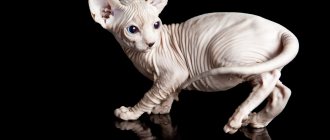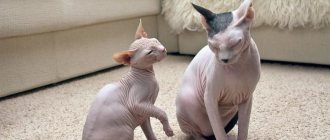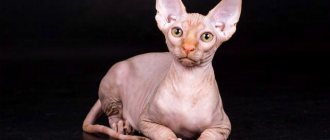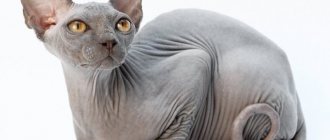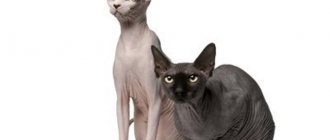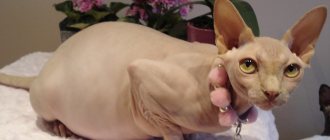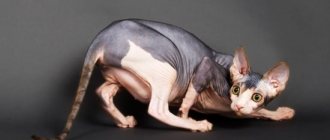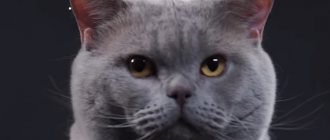The Sphynx cat is considered a unique animal, despite the fact that many are repulsed by their appearance and do not evoke pleasant associations with furry pets. The main difference from other cat breeds is short or completely absent hair. Sphinxes are rightly considered one of the most ancient breeds, representatives of which were found back in the days of the pharaohs. They can be called the same age as the great Egyptian pyramids.
In those days they were considered sacred and protected by laws. The life of cats was valued much higher than the life of a slave; they were worshiped and sought to please. Of course, in our time it is unlikely that sphinxes are deified anywhere else, but they still have a sophisticated expression on their faces, a piercing, attentive gaze and devotion to their owners.
White Sphynx kitten.
Key facts
The official name of the breed is Sphynx, but in Russia it is called Canadian, referring to its country of origin. This is used to distinguish the breed from other hairless cats: the Don and St. Petersburg Sphynxes.
These cats are characterized by sexual dimorphism. In the picture with different-sex animals, it is easy to understand which of them is a boy and which is a girl. The description of the Canadian Sphynx breed states that the maximum weight of a female is 4 kg, and the weight of a male is 7 kg. The height at the withers should be no more than 30 cm. The average life expectancy of the Canadian Sphynx is 15 years.
The price for show-class representatives with a rare color and prestigious pedigree often reaches 150 thousand rubles. By letting your pet go for an independent walk outside the home, you are taking a risk. It stands out well among other animals, so it can become a victim of thieves.
The main characteristic of the Canadian Sphynx is the absence of the usual coat. This phenomenon is explained by a genetic mutation that arose without human intervention.
Due to increased appetite and omnivorousness, the animal quickly turns into a bald “barrel”. To maintain good physical shape, you need to constantly monitor the amount of food you eat and maintain activity.
Also, the disadvantages of the Sphynx cat include vulnerability to drafts and the scorching sun. Future owners will have to stock up on knitted sweaters and sunscreen.
After meeting the sphinx, it is difficult to remain indifferent. They adore human company and have a hard time enduring hours of loneliness. If you have a dog or other animal, then the “Canadian” will become an excellent friend. The more animals you have in your family, the easier it is for your cat to tolerate separation from its beloved owner.
Advantages and disadvantages
When choosing a breed that you plan to get, the choice often falls on Sphynxes. But before that, you need to know everything about sphinxes, their differences, features, habits, and most importantly, their advantages and disadvantages. The main advantages of sphinxes are:
- activity;
- curiosity, but sometimes this can be considered a disadvantage;
- tenderness and affection;
- communication skills with people and animals.
The disadvantages include the need to frequently bathe the animal, otherwise it will dirty the furniture, leaving gray-yellow stains on it. They are also afraid of the cold; the owner must monitor the temperature in the apartment very closely. Sometimes a cat can get bored with a person due to over-attachment.
History of the origin of the Canadian Sphynx
Images of cats without fur are found in chronicles found in excavations of ancient civilizations. For a long time, such animals were considered a natural anomaly and were discarded from breeding. The situation changed in the 1960s.
The hairless kitten was discovered in Canada, the recognized country of origin of the breed. He was born by an ordinary short-haired cat. The owner named the baby Prune and crossed him with his mother when he grew up. The mating was successful, and the woman received another offspring with hairless kittens. After 10 years, breeding along this line was interrupted. The American state of Minnesota took over the baton.
The ancestors of the modern Sphynx cat were two cats from the small town of Baden. During breeding work, they were crossed with other breeds, but without interrupting the line. Curly Devon Rexes and other hairless cats found in Canada were used for breeding.
Among the interesting facts associated with the breed, it is worth noting the history of the origin of its name. For a long time, the Sphynx was called the “Canadian hairless cat,” but breeders wanted to secure a more original name. The choice fell on the Egyptian Sphinx - the main attraction of the pyramid complex in Giza.
Until 1986, felinologists had a negative attitude towards the gene responsible for the coat mutation. After numerous studies, the theory of possible genetic diseases was refuted. The first international organization to recognize the Canadian Sphynx was TICA. Other organizations introduced a description of the new breed a little later. The CCA developed the standard in 1992, and the CFA only in 2002.
Types of Sphynx cats
The Sphynx breed is represented by three species. In addition to the Canadian one, there is also the Don variety, which was bred in Rostov-on-Don, and the Peterbald - the creation of breeders from St. Petersburg.
The Canadian Sphynx is smaller than the Don Sphynx. The standard for this breed was approved in 1992. The Peterbald was obtained by crossing the Don variety with Oriental cats about 20 years ago.
What does the Canadian Sphynx look like?
The general impression made by the sphinxes is deceptive. The illusory weightlessness created by the absence of fur collapses the moment the animal is picked up. A tightly built body is covered in muscles, and muscles are always heavier than fat. Therefore, in the photo, the Canadian Sphynx may seem deceptively fragile.
Muzzle
What does a Canadian Sfinsky look like from different angles? The breed is characterized by a wedge-shaped head. Its width is slightly shorter than its length. The short muzzle is covered with pronounced folds. On well-developed whisker pads, the vibrissae are absent or grow to a short length. The Sphinx has high cheekbones and a strong chin. The transition from a flat forehead to a short nose is weakly expressed.
Huge ears with a wide base are the hallmark of the breed. There is a slight difference in the TICA and CFA standards that determine what the Sphynx looks like. The first organization allows a small amount of hair on the outside of the ears, and the second considers it a breed defect. Fur inside the ears is unacceptable under both standards.
The shape of the large and slightly slanted eyes resembles a lemon. They are widened towards the center and narrowed at the edges. The color of the iris should be in harmony with the color of the coat.
Body type
The head is located on a slightly arched neck of medium length. The body of the Sphinx is heavy and muscular. The muscles of cats are more developed than those of cats. The areas of the croup, abdomen and chest are rounded. The belly resembles a barrel, so it seems that the cat has recently eaten. There should be no fat deposits.
The hind limbs are longer than the front limbs, so the line of the back behind the shoulder blades is raised. The paws have an oval shape and thick pads with long and graceful toes. The fingers are well developed, so cats can open doors or take small objects into them. The animal's tail resembles a rat's. It is long and flexible, and its tapered tip allows for a small amount of hair.
Coat and color
Cats have thick and folded skin. The greatest number of folds is found on the limbs and muzzle. Instead of the classic guard hair and undercoat, soft and short fluff grows on the body. Its length does not exceed 2 mm. The tail, scrotum, outer side of the ears and the interdigital space are covered with short and sparse hair.
The coat feels like suede or velor to the touch. Hairlessness is only visible, so the standard allows any colors of the Canadian Sphynx, except shaded and zonal: smoky, chinchilla, cameo and others. Also, shorn animals are not allowed to participate in the exhibition.
Varieties of the Canadian Sphynx are the St. Petersburg and Don Sphynxes. Recently, in some countries they are considered separate breeds.
Popular Sphynx colors
Sphynx cats come in a variety of colors, many of which differ from standard cat colors.
In general, cat colors are classified as follows:
- Solid - the color of the cat's body is uniformly one color from the whiskers to the tip of the tail. The color is necessarily intense;
- Tortoiseshell - a combination of several colors, in particular black and red. There are no strict requirements for tortoiseshell colors, since during selection they are modified in every possible way;
- Tabbies are striped, spotted and marbled cats, in which a contrasting pattern is clearly visible;
- Bicolors - a combination of white and primary colors;
- Colored cats are the color of Siamese cats.
In particular, the following colors are available for Sphynxes of various breeds:
- Classic: white, black, blue, red, cream, chocolate;
- Lilac – gray with a pinkish tint. The nose and paws remain bright pink;
- Cinnamon – brown color;
- Background – pale pink color;
- Classic tabby - with markings on the paws and tail, curls on the cheeks. Original color with many markings consisting of lines and spots;
- Mackerel - the legs are colored in rings that smoothly turn into markings throughout the body;
- Spotted tabby - markings on the body in the form of spots;
- Thorby is a tortoiseshell color that combines silver, blue, red and other colors;
- Silver, brown, blue, red, cream tabby;
- Calico - aka chintz. White color with pale black and red spots;
- Van Calico - white with blue and cream spots;
- Point - a color in which numerous points of different colors are located on the body of the sphinx;
- Sable – brown color without any markings;
- Platinum is a honey-beige color of a cat.
The character of the Canadian Sphynx
The Arabs called the Egyptian sphinx the Father of Terror, but the Canadian cat took only the name from the ancient sculpture. Unlike a lion with a human head, bald animals are kindness itself. The devoted nature of the Canadian Sphynx is reminiscent of a dog.
Sphinxes have an intolerant attitude towards loneliness. They become attached not to a place, but to a person. The owner's long absence makes them depressed. These animals have a hard time with family changes, so weigh the pros and cons before getting a kitten.
At home, “Canadians” do not leave their owner’s side and love to lie in his arms. These cats are friendly and highly active. They quickly find contact with children of any age. A small child will be safe with this mischievous pet, since aggression is alien to the cat. If you are often absent from work, then find company for the sphinx. They get along well with other animals and do not have hunting habits. Any pet is suitable as a playmate: another cat, dog, bird or rodent.
The breed is characterized by high intelligence, so buy some interactive toys and try training. Sphinxes are open to communication, so they are not afraid of large crowds of strangers.
Thanks to their equanimity, they give good results at exhibitions, and some representatives managed to appear in the world of show business. The role of the balding Persian cat, the favorite pet of Dr. Evil from the movie "Austin Powers", was played by a Canadian Sphynx.
Pros and cons of sphinxes
The most obvious advantage of Sphynx cats is the lack of hair. Cats do not cause allergies, they do not need to be combed, and the hair that falls out does not settle on clothes, furniture or the floor. Like fluffy cats, Sphynx cats are pleasant to the touch and love affection in the same way.
Sphynxes are affectionate and loving – this is also a plus for ardent cat lovers. Sphinxes will always be happy to be stroked and will never refuse to sit on their owner’s lap. They love to sleep with people under a blanket and, moreover, sphinxes are very warm, so they can even warm their owner.
Fun fact: Sphynx cats are smart and easy to train. They will be happy to perform simple tricks if you handle the animal correctly. They usually willingly make contact with people who have always been respectful to them.
Sphynx cats love to play, so they can be kept in families with children. They also get along easily with other animals. Sphynx cats are in good health, although regular check-ups by veterinarians should not be neglected.
Sphynx kittens are born strong and healthy and quickly open their eyes. Sometimes little sphinxes are born sighted. Also, since childhood, they have a good appetite and willingly eat both homemade food and feed.
Sphinxes also have negative sides. The most basic of them is that cats sweat a lot. The fact is that in ordinary cats all the sweat is absorbed into the undercoat and evaporates, but Sphynx cats do not have such an undercoat. Their sweat has an odor and an unpleasant brown tint. If a cat sweats while sitting on light-colored furniture or clothing, the stain will certainly remain. Such stains are almost impossible to remove.
Sphynxes are playful and curious, and if they are not provided with the necessary toys, they will find them themselves: they will rip curtains, eat pins and do other unpleasant things. Sphynx cats are also clean, so they won’t want to visit a litter box that already has a strong smell.
Raising a Sphynx
After the kitten appears, it is important to start raising it. For toilet training, buy several trays and place them in places where your pet tries to relieve himself. Gradually reduce their number and move them closer to the bathroom or toilet. Don't scold your baby if he goes past the litter box. Wipe the area with vinegar solution or spray with anti-cat spray. Be sure to praise your pet if he has done his business in the right place. Praise will generally have a beneficial effect on the education of the Canadian Sphynx.
If problems with the tray occur in an adult animal, then try to understand the possible causes. Sphynxes are clean cats. If they mark territory, this may be due to stress or a physiological disease (cystitis, urolithiasis, diabetes).
All cats wear down their claws, so discourage attempts to scratch the sofa and offer an alternative. Multi-level scratching posts are suitable for sharpening claws and maintaining physical fitness. Some pets use such structures only for play. Try to solve this problem with a horizontal scratching post.
Training cats is more difficult than training dogs. With constant training, the Sphinx can be taught basic commands. Start training the commands “come to me” and “fetch” no earlier than 8-9 months. Try to give exercise in the form of a game and be sure to reward your cat with treats for its success.
Looking for a Sphynx? Find your pet from 3 offers Buy as a gift
Education and physical activity
When raising a Sphinx, you need to be persistent and patient. When training a cat, you should not yell at it or use force on it. It is better to use the incentive method. Every time your cat does what is expected of her, you should give her a treat.
Using this approach, the Sphinx can be taught:
- bring the ball on command;
- to open the door;
- and even flush the toilet.
Health of the Canadian Sphynx
With proper care and maintenance, Sphynx cats can live up to 16 years. Health problems can arise due to overheating or hypothermia. Due to the lack of wool, the breed is dependent on temperature changes.
An animal can also become infected with the virus if the owner neglects annual vaccinations. To maintain immunity, it is recommended to give your pet vitamins. The dosage and names of the drugs are prescribed by the veterinarian. Independent choice on the advice of friends is not allowed and can harm the animal.
Possible diseases
Sphynxes often suffer from dermatological diseases. Peach fluff does not protect hypersensitive skin. Cats may develop urticaria pigmentosa on the face, paws, ears, or other parts of the body. Rashes and redness can also be explained by food allergies. To detect it, you will have to take your pet to the veterinarian and undergo all the necessary tests.
Among the genetic diseases of the breed that are inherited are progressive muscle dysfunction. There is no treatment for this pathology, obtained by crossing with Devon Rex. The first symptoms appear at 1-2 months, but sometimes are absent until 3-3.5 months. The disease occurs individually, but most often leads to death due to laryngospasm - involuntary closure of the glottis caused by spasm of the muscles of the larynx. Before purchasing, check with the seller which kittens are at risk.
Also among common diseases is hypertrophic cardiomyopathy. It may be asymptomatic or accompanied by increased heart rate and periodic fainting. The life expectancy of a sick pet depends on the severity of the symptoms shown. With smoothed symptoms and timely drug treatment, veterinarians give a positive prognosis.
Reproductive health
After six months, the pet should go into heat. If you do not plan to take care of the offspring, then after it is completed, take the cat for sterilization. Empty heats have a negative impact on the health of the animal, and timely surgery protects against cancer and negates sexual desire. Males mature a little later - by 8 months.
Recommended age for first mating: 1-1.5 years for cats and 1.5-2 years for males. Both animals must be vaccinated and dewormed. The ovulation period occurs on days 3-5, so the probability of successful conception on these days is maximum.
Pregnancy lasts 63 days. Typically, a cat gives birth to up to 12 kittens, so owners often have to resort to artificial feeding.
Video
* We invite you to watch a video about the Sphinx . In fact, in front of you is a playlist in which you can select and watch any of 20 videos about a given cat breed by simply clicking on the button in the upper right corner of the window. In addition, the material contains quite a lot of photos. By looking at them you can find out what the Sphinx looks like.
In this article:
|
Features of feeding and diet
The intense heat exchange caused by the lack of wool consumes a large amount of energy. It takes a lot of calories to maintain it, so cats are constantly hungry. If you do not follow feeding standards, your pet will suffer from obesity.
After 2 months, kittens are separated from their mother. They can be given boiled or well-frozen meat, cut into small pieces. For the development of teeth and skeleton you will need cottage cheese and eggs. When feeding dry food, choose lines designed for kittens. They contain a lot of calories and vitamins, which is important for a young body. If your pet has not yet grown permanent teeth, then it is better to pre-soak the food in water.
Up to 4 months, animals are fed 5-6 times a day, from 4 to 7 months - 3-4 times a day, from 7 to 12 months - 3 times a day. After 1 year, the number of meals is reduced to 2 times. The pet should eat 5% of its body weight per day, but it is better to agree on the exact amount with your veterinarian.
With a natural diet, it is recommended to consume:
- lean meat and offal;
- vegetables and herbs;
- croup
You can add a cracker to your diet once a week. It helps clear plaque and prevents the formation of tartar. If your pet eats dry food, then you don’t need to give him crackers. Mixing natural and dry feeding is dangerous for the gastrointestinal tract.
Not all owners can prepare fresh meals for their pets every day. The simplest and safest way to feed is dry. Super-premium industrial feeds contain all the necessary nutritional elements. With them you won’t have to rack your brains to calculate the KBJU. All feeding recommendations are listed in the table on the package.
Care and maintenance
Allergy sufferers should pay attention to the fact that a cat is no less allergenic than its long-haired relatives, and sometimes more. This is due to the fact that wool rarely acts as an allergen. Most often, allergic reactions are provoked by animal biological fluids: saliva and urine.
Despite the lack of hair, the Sphynx requires more painstaking care than other breeds. Its shedding does not threaten the cleanliness of sofas and beds, but instead of fur, the pet can leave greasy stains on the furniture. This occurs due to increased production of sebaceous secretions. Neglect of hygiene is fraught not only with pollution, but also with the development of dermatological diseases.
For the health of the pet and the cleanliness of the apartment, it is recommended to carry out weekly bathing procedures. Get your cat used to bathing from an early age to avoid hassle in the future. On other days, it is enough to wipe the pet with an important sponge.
Due to the small amount of fur, the Sphynx is vulnerable to drafts. Be sure to wrap him in a towel after a bath and dress him in warm clothes in the fall and winter. In addition to the cold, animals are vulnerable to direct sunlight. They can get sunburned and scalded, so it is not recommended to take them outside.
The advantage of the breed is savings on grooming. The pet gets along just fine without brushing or haircuts. If your cat scratches during play because its claws are too long, but constantly uses a scratching post, trim the claws yourself. This procedure will have to be taught from childhood, since most animals are horrified at the sight of a manicure set.
To keep your Sphynx comfortable, you need to purchase a bed, a tray, toys, and bowls for water and food. Often the owner's bed turns out to be more attractive than the most expensive house. We can only come to terms with this fact.
Large ears quickly accumulate dust and dirt. Clean them regularly with a cotton pad soaked in water or a special solution. Cotton pads are also suitable for daily eye cleansing. They must be different for each eye, as otherwise the risk of infection increases. Care for your mouth with veterinary toothpaste. It removes plaque from teeth and leaves a pleasant smell.
Diseases and health problems
Sphynxes have a very strong immune system, so with proper care they will not catch colds or suffer from infectious diseases. But these animals have a number of birth defects that can manifest themselves in one form or another.
For example, the so-called “carp bite”, in which the lower jaw of the sphinx is slightly shortened. Cats' incisors do not touch, the jaw becomes warped, and tooth asymmetry occurs. Due to the fact that the teeth dig into the hard palate, ulcers and wounds constantly appear on it.
There is also a disease called microphthalmia, in which kittens’ eyes develop incorrectly, causing them to decrease in size. This is fraught with many eye diseases that need to be monitored by a veterinarian. Sometimes cysts and tumors appear in the eyes. A similar disease is entropion of the eyelids, which causes animals to suffer from conjunctivitis for life.
Important fact: Curvature of the caudal spine is also not a rare occurrence among sphinxes. Often kittens are simply born non-viable and die early. This disease is fraught with intestinal abnormalities, a weak digestive system, short stature and underdeveloped thoracic region.
Nipple hyperplasia occurs among female Sphynx cats and is inherited. It usually affects cats with light blue or blue-cream skin and blue eyes. It is impossible to diagnose it immediately, but it appears gradually. At the age of one year, kittens' nipples turn red, and the skin around them gradually thickens. Cysts may appear.
Cats with this disease should not be bred. Cubs can be born with pathological internal organs, which is why they often die. These cats also produce very little milk. Hyperplasia can occur if a cat is given hormones that suppress sexual desire.
Tips for choosing a kitten
You should not purchase a kitten through private sellers. Photos of hairless cats posted on a free message board on the Internet may turn out to be fictitious. Outbred shaved cats are often passed off as Sphynxes. It is almost impossible to spot deception without the help of an experienced breeder or felinologist.
You can purchase a healthy and purebred animal from a large nursery or from a professional breeder who is a member of a club or association of cat lovers. In both cases, sellers are required to present a license confirming the legality of their activities. Along with the kitten, the buyer must receive a purchase and sale agreement, a veterinary passport and breeding documents. Breeding documents include:
- Metrics. Contains basic information about the kitten and its parents. If the animal belongs to the pet class, then its defects are reflected in the metric: excessive amount of fur, insufficient number of folds, and others.
- Pedigree. Unlike the metric, it is issued at the buyer’s request and increases the final cost of the kitten. If you do not plan to breed or participate in an exhibition, then you can refuse the pedigree. In this case, the price of the pet will be lower.
When choosing among Sphynx kittens, consider your purchase goals. If you buy a pet for the soul, then it is enough to choose a healthy and active animal. Buyers with higher demands are advised to seek advice from a felinologist, breeder or veterinarian.
Breed Features
Character
Breeders try to present Canadian Sphynx cats as real angels. But it is not always the case.
- The character of these animals largely depends on the conditions of detention and the behavior of the owner. Sphinxes show affection for people and need close communication with them. From all the inhabitants of the house they choose their owner. And this is not necessarily the head of the family. Canadians prefer someone who is especially affectionate with them, allows them to lie on their laps, strokes them and takes them into their bed at night.
- Canadians are very curious and always want to be involved in the lives of family members. And it doesn't matter what you do. They will jump on the mop while cleaning the floor, chew on the pen you write with, and look at the magazine you are reading.
- The Canadian Sphynx is a very active, playful breed. Therefore, such cats need all kinds of entertainment. If you leave a Canadian without toys and supervision, he will turn the apartment upside down.
Important! Canadian Sphynx cats are very touchy, so they cannot be punished even if they do something wrong. They remember any rudeness from the owner for a long time, and as a result they may completely stop obeying.
Interaction with adults and children
Canadians easily find a common language with all family members, regardless of age. Canadian Sphynxes are wary of strangers. When trying to pet or pick up, they may become aggressive.
These cats simply adore children. Fun games, running around the room accompanied by little companions is a favorite pastime of Canadians. Moreover, they will not even respond to aggression from the child. The Sphynx will prefer to run and hide, but will not bite or scratch the baby.
Relationships with other animals
Hairless cats prefer to be the only pets in the house. They can hardly stand being around other animals. But some individuals are able to find a compromise with their neighbors. They will not feel any special love for other cats or dogs in the house, but they can live at some distance and in a conditionally divided territory.
How much does a Sphynx cost?
The price of a Canadian Sphynx starts from 8-15 thousand rubles. For this amount you can purchase a pet-class animal. For breeding, it is recommended to take animals from American or European nurseries with good pedigree. For elite cats you will have to stand in line. The waiting period can take up to 5 years.
If the number of awards won by the kitten’s parents is not a priority, then check reviews of nurseries in your city and feel free to go for the first meeting with your future pet
Do you like the article? 0
How to choose the right kitten
When choosing a purebred kitten, there is no need to try to save money. It is better to buy a four-legged friend from a nursery with a good reputation. The breeder is responsible for each animal he sells, so he will not cheat. Kittens are sold with all documents - veterinary vaccination certificates, pedigree, passport.
Before buying a Sphynx, it is advisable to get to know his parents better, because later the baby will look like them. For those who do not intend to continue breeding hairless cats, a pet-class pet is suitable. This is a healthy cat that has minor conformation defects and therefore cannot participate in breeding work. Such sphinxes are cheaper and are bred solely for maintenance.
Kitten care
There are 3-5 kittens in a cat's litter. They are born blind. Babies' eyes open around the 3-4th day. In the first weeks after lambing, the mother takes care of the babies. She feeds, washes and warms the cubs with her body.
A month later, the sphinxes are given their first complementary foods. You can give low-fat cottage cheese or boiled lean chopped meat. Until the age of three months, cats are fed 6 times a day, then they are transferred to four meals a day. Adults eat in the morning and evening.
Small Sphynx cats require special care. It is important to keep your skin clean, as it quickly becomes oily. Once a week, the cat should be washed with warm water without soap, and wiped daily with wet wipes. The eyes and ears of naked cats are carefully cleaned with cotton pads soaked in a special product.
